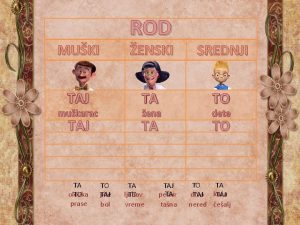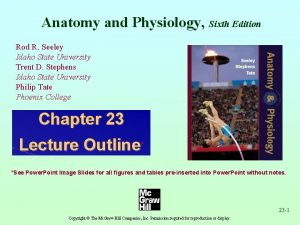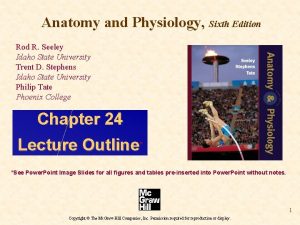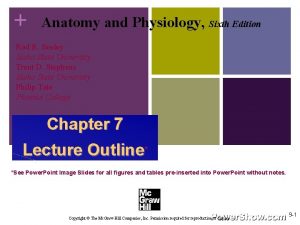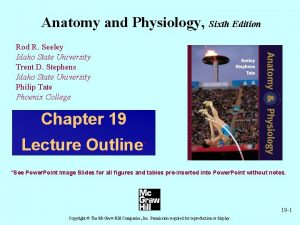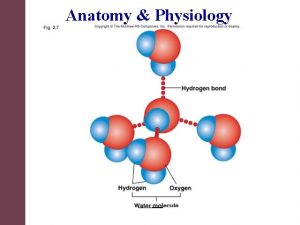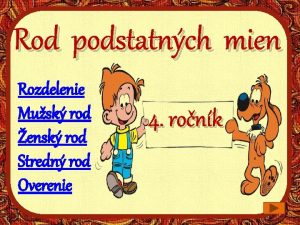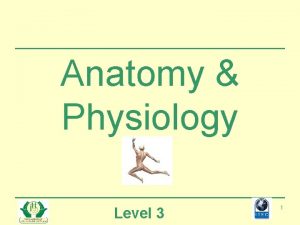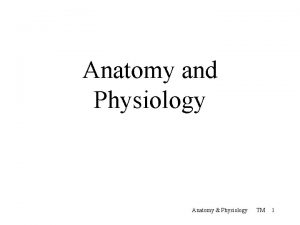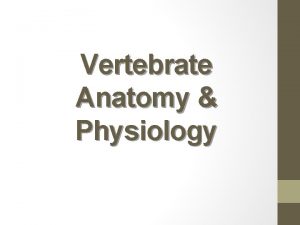Anatomy and Physiology Sixth Edition Rod R Seeley
















































- Slides: 48

Anatomy and Physiology, Sixth Edition Rod R. Seeley Idaho State University Trent D. Stephens Idaho State University Philip Tate Phoenix College Chapter 23 Lecture Outline* *See Power. Point Image Slides for all figures and tables pre-inserted into Power. Point without notes. 23 -1 Copyright © The Mc. Graw-Hill Companies, Inc. Permission required for reproduction or display.

Chapter 23 Respiratory System 23 -2

Respiration • Ventilation: Movement of air into and out of lungs • External respiration: Gas exchange between air in lungs and blood • Transport of oxygen and carbon dioxide in the blood • Internal respiration: Gas exchange between the blood and tissues 23 -3

Respiratory System Functions • Gas exchange: Oxygen enters blood and carbon dioxide leaves • Regulation of blood p. H: Altered by changing blood carbon dioxide levels • Voice production: Movement of air past vocal folds makes sound and speech • Olfaction: Smell occurs when airborne molecules are drawn into nasal cavity • Protection: Against microorganisms by preventing entry and removing them 23 -4

Respiratory System Divisions • Upper tract – Nose, pharynx and associated structures • Lower tract – Larynx, trachea, bronchi, lungs 23 -5

Nasal Cavity and Pharynx 23 -6

Nose and Pharynx • Nose – External nose – Nasal cavity • Functions – – – Passageway for air Cleans the air Humidifies, warms air Smell Along with paranasal sinuses are resonating chambers for speech • Pharynx – Common opening for digestive and respiratory systems – Three regions • Nasopharynx • Oropharynx • Laryngopharynx 23 -7

Larynx • Functions – Maintain an open passageway for air movement – Epiglottis and vestibular folds prevent swallowed material from moving into larynx – Vocal folds are primary source of sound production 23 -8

Vocal Folds 23 -9

Trachea Insert Fig 23. 5 all but b • Windpipe • Divides to form – Primary bronchi – Carina: Cough reflex 23 -10

Tracheobronchial Tree • Conducting zone – Trachea to terminal bronchioles which is ciliated for removal of debris – Passageway for air movement – Cartilage holds tube system open and smooth muscle controls tube diameter • Respiratory zone – Respiratory bronchioles to alveoli – Site for gas exchange 23 -11

Tracheobronchial Tree 23 -12

Bronchioles and Alveoli 23 -13

Alveolus and Respiratory Membrane 23 -14

Lungs • Two lungs: Principal organs of respiration – Right lung: Three lobes – Left lung: Two lobes • Divisions – Lobes, bronchopulmonary segments, lobules 23 -15

Thoracic Walls Muscles of Respiration 23 -16

Thoracic Volume 23 -17

Pleura • Pleural fluid produced by pleural membranes – Acts as lubricant – Helps hold parietal and visceral pleural membranes together 23 -18

Ventilation • Movement of air into and out of lungs • Air moves from area of higher pressure to area of lower pressure • Pressure is inversely related to volume 23 -19

Alveolar Pressure Changes 23 -20

Changing Alveolar Volume • Lung recoil – Causes alveoli to collapse resulting from • Elastic recoil and surface tension – Surfactant: Reduces tendency of lungs to collapse • Pleural pressure – Negative pressure can cause alveoli to expand – Pneumothorax is an opening between pleural cavity and air that causes a loss of pleural pressure 23 -21

Normal Breathing Cycle 23 -22

Compliance • Measure of the ease with which lungs and thorax expand – The greater the compliance, the easier it is for a change in pressure to cause expansion – A lower-than-normal compliance means the lungs and thorax are harder to expand • Conditions that decrease compliance – Pulmonary fibrosis – Pulmonary edema – Respiratory distress syndrome 23 -23

Pulmonary Volumes • Tidal volume – Volume of air inspired or expired during a normal inspiration or expiration • Inspiratory reserve volume – Amount of air inspired forcefully after inspiration of normal tidal volume • Expiratory reserve volume – Amount of air forcefully expired after expiration of normal tidal volume • Residual volume – Volume of air remaining in respiratory passages and lungs after the most forceful expiration 23 -24

Pulmonary Capacities • Inspiratory capacity – Tidal volume plus inspiratory reserve volume • Functional residual capacity – Expiratory reserve volume plus the residual volume • Vital capacity – Sum of inspiratory reserve volume, tidal volume, and expiratory reserve volume • Total lung capacity – Sum of inspiratory and expiratory reserve volumes plus the tidal volume and residual volume 23 -25

Spirometer and Lung Volumes/Capacities 23 -26

Minute and Alveolar Ventilation • Minute ventilation: Total amount of air moved into and out of respiratory system per minute • Respiratory rate or frequency: Number of breaths taken per minute • Anatomic dead space: Part of respiratory system where gas exchange does not take place • Alveolar ventilation: How much air per minute enters the parts of the respiratory system in which gas exchange takes place 23 -27

Physical Principles of Gas Exchange • Partial pressure – The pressure exerted by each type of gas in a mixture – Dalton’s law – Water vapor pressure • Diffusion of gases through liquids – Concentration of a gas in a liquid is determined by its partial pressure and its solubility coefficient – Henry’s law 23 -28

Physical Principles of Gas Exchange • Diffusion of gases through the respiratory membrane – Depends on membrane’s thickness, the diffusion coefficient of gas, surface areas of membrane, partial pressure of gases in alveoli and blood • Relationship between ventilation and pulmonary capillary flow – Increased ventilation or increased pulmonary capillary blood flow increases gas exchange – Physiologic shunt is deoxygenated blood returning from lungs 23 -29

Oxygen and Carbon Dioxide Diffusion Gradients • Oxygen – Moves from alveoli into blood. Blood is almost completely saturated with oxygen when it leaves the capillary – P 02 in blood decreases because of mixing with deoxygenated blood – Oxygen moves from tissue capillaries into the tissues • Carbon dioxide – Moves from tissues into tissue capillaries – Moves from pulmonary capillaries into the alveoli 23 -30

Changes in Partial Pressures 23 -31

Hemoglobin and Oxygen Transport • Oxygen is transported by hemoglobin (98. 5%) and is dissolved in plasma (1. 5%) • Oxygen-hemoglobin dissociation curve shows that hemoglobin is almost completely saturated when P 02 is 80 mm Hg or above. At lower partial pressures, the hemoglobin releases oxygen. • A shift of the curve to the left because of an increase in p. H, a decrease in carbon dioxide, or a decrease in temperature results in an increase in the ability of hemoglobin to hold oxygen 23 -32

Hemoglobin and Oxygen Transport • A shift of the curve to the right because of a decrease in p. H, an increase in carbon dioxide, or an increase in temperature results in a decrease in the ability of hemoglobin to hold oxygen • The substance 2. 3 -bisphoglycerate increases the ability of hemoglobin to release oxygen • Fetal hemoglobin has a higher affinity for oxygen than does maternal 23 -33

Oxygen-Hemoglobin Dissociation Curve at Rest 23 -34

Oxygen-Hemoglobin Dissociation Curve during Exercise 23 -35

Shifting the Curve 23 -36

Transport of Carbon Dioxide • Carbon dioxide is transported as bicarbonate ions (70%) in combination with blood proteins (23%) and in solution with plasma (7%) • Hemoglobin that has released oxygen binds more readily to carbon dioxide than hemoglobin that has oxygen bound to it (Haldane effect) • In tissue capillaries, carbon dioxide combines with water inside RBCs to form carbonic acid which dissociates to form bicarbonate ions and hydrogen ions 23 -37

Transport of Carbon Dioxide • In lung capillaries, bicarbonate ions and hydrogen ions move into RBCs and chloride ions move out. Bicarbonate ions combine with hydrogen ions to form carbonic acid. The carbonic acid is converted to carbon dioxide and water. The carbon dioxide diffuses out of the RBCs. • Increased plasma carbon dioxide lowers blood p. H. The respiratory system regulates blood p. H by regulating plasma carbon dioxide levels 23 -38

Carbon Dioxide Transport and Chloride Movement 23 -39

Respiratory Areas in Brainstem • Medullary respiratory center – Dorsal groups stimulate the diaphragm – Ventral groups stimulate the intercostal and abdominal muscles • Pontine (pneumotaxic) respiratory group – Involved with switching between inspiration and expiration 23 -40

Respiratory Structures in Brainstem 23 -41

Rhythmic Ventilation • Starting inspiration – Medullary respiratory center neurons are continuously active – Center receives stimulation from receptors and simulation from parts of brain concerned with voluntary respiratory movements and emotion – Combined input from all sources causes action potentials to stimulate respiratory muscles • Increasing inspiration – More and more neurons are activated • Stopping inspiration – Neurons stimulating also responsible for stopping inspiration and receive input from pontine group and stretch receptors in lungs. Inhibitory neurons activated and relaxation of respiratory muscles results in expiration. 23 -42

Modification of Ventilation • Chemical control • Cerebral and limbic system – Respiration can be voluntarily controlled and modified by emotions – Carbon dioxide is major regulator • Increase or decrease in p. H can stimulate chemosensitive area, causing a greater rate and depth of respiration – Oxygen levels in blood affect respiration when a 50% or greater decrease from normal levels exists 23 -43

Modifying Respiration 23 -44

Regulation of Blood p. H and Gases 23 -45

Herring-Breuer Reflex • Limits the degree of inspiration and prevents overinflation of the lungs – Infants • Reflex plays a role in regulating basic rhythm of breathing and preventing overinflation of lungs – Adults • Reflex important only when tidal volume large as in exercise 23 -46

Ventilation in Exercise • Ventilation increases abruptly – At onset of exercise – Movement of limbs has strong influence – Learned component • Ventilation increases gradually – After immediate increase, gradual increase occurs (4 -6 minutes) – Anaerobic threshold is highest level of exercise without causing significant change in blood p. H • If exceeded, lactic acid produced by skeletal muscles 23 -47

Effects of Aging • Vital capacity and maximum minute ventilation decrease • Residual volume and dead space increase • Ability to remove mucus from respiratory passageways decreases • Gas exchange across respiratory membrane is reduced 23 -48
 Muski zenski i srednji rod imenica
Muski zenski i srednji rod imenica Endomysium
Endomysium Anatomy and physiology edition 9
Anatomy and physiology edition 9 Human anatomy and physiology 10th edition
Human anatomy and physiology 10th edition Peter piper tongue twister
Peter piper tongue twister Rubber baby buggy bumpers tongue twister lyrics
Rubber baby buggy bumpers tongue twister lyrics Biochemistry sixth edition 2007 w.h. freeman and company
Biochemistry sixth edition 2007 w.h. freeman and company Computer architecture a quantitative approach sixth edition
Computer architecture a quantitative approach sixth edition Automotive technology principles diagnosis and service
Automotive technology principles diagnosis and service Automotive technology sixth edition
Automotive technology sixth edition Apa sixth edition
Apa sixth edition Computer architecture a quantitative approach sixth edition
Computer architecture a quantitative approach sixth edition Precalculus sixth edition
Precalculus sixth edition Rational people think at the margin
Rational people think at the margin Computer architecture a quantitative approach sixth edition
Computer architecture a quantitative approach sixth edition Physiology of sport and exercise 5th edition
Physiology of sport and exercise 5th edition Upper respiratory tract labeled
Upper respiratory tract labeled Tattoo anatomy and physiology
Tattoo anatomy and physiology Science olympiad anatomy and physiology
Science olympiad anatomy and physiology Incomplete flower
Incomplete flower Anatomy and physiology bone
Anatomy and physiology bone Gastric ulcer
Gastric ulcer Segmental anatomy of the liver
Segmental anatomy of the liver Difference between anatomy and physiology
Difference between anatomy and physiology Iliac regions
Iliac regions Blood in anatomy and physiology
Blood in anatomy and physiology The central sulcus divides which two lobes? (figure 14-13)
The central sulcus divides which two lobes? (figure 14-13) Http://anatomy and physiology
Http://anatomy and physiology Chapter 1 introduction to human anatomy and physiology
Chapter 1 introduction to human anatomy and physiology Appendectomy anatomy and physiology
Appendectomy anatomy and physiology Aohs foundations of anatomy and physiology 1
Aohs foundations of anatomy and physiology 1 Aohs foundations of anatomy and physiology 1
Aohs foundations of anatomy and physiology 1 Anatomy and physiology of swine
Anatomy and physiology of swine Anatomy and physiology chapter 8 special senses
Anatomy and physiology chapter 8 special senses Chapter 13 anatomy and physiology of pregnancy
Chapter 13 anatomy and physiology of pregnancy Unit 26 agriscience
Unit 26 agriscience Science olympiad anatomy and physiology 2020 cheat sheet
Science olympiad anatomy and physiology 2020 cheat sheet Anatomy and physiology chapter 2
Anatomy and physiology chapter 2 Contraction
Contraction Anatomy and physiology of pancreas
Anatomy and physiology of pancreas Anatomy and physiology chapter 7
Anatomy and physiology chapter 7 Chapter 14 the digestive system and body metabolism
Chapter 14 the digestive system and body metabolism Chapter 10 blood anatomy and physiology
Chapter 10 blood anatomy and physiology Aohs foundations of anatomy and physiology 1
Aohs foundations of anatomy and physiology 1 Aohs foundations of anatomy and physiology 1
Aohs foundations of anatomy and physiology 1 Anatomy and physiology
Anatomy and physiology Anatomy and physiology chapter 15
Anatomy and physiology chapter 15 Cornell notes for anatomy and physiology
Cornell notes for anatomy and physiology Necessary life functions anatomy and physiology
Necessary life functions anatomy and physiology
